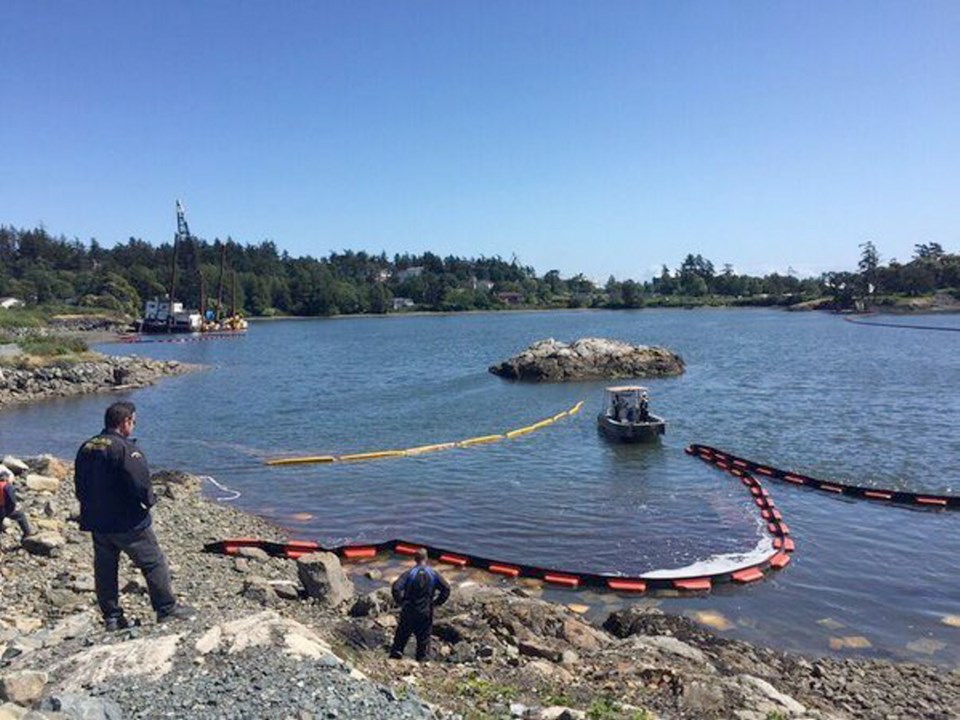Cleanup crews are focusing on the shoreline of Plumper Bay after a barge carrying up to 30,000 litres of diesel ran aground in Esquimalt Harbour.
Vancouver Pile Driving said its construction barge contained between 20,000 and 30,000 litres when it broke loose in high winds early Sunday morning and hit the shore.
On Monday, a red Canadian Coast Guard helicopter circled over the small protected bay surveying the impact of the spill.
The large construction barge, which carries a crane, ran aground near the mouth of Plumper Bay. The sandy rock-strewn beach is ringed by Esquimalt Nation on one side and Songhees Nation on the other.
The Esquimalt Nation administration office is being used as a command post for cleanup and monitoring crews for various stakeholders including the provincial and federal governments.
The smell of diesel hung in the air Monday as First Nations and crews from Vancouver Pile Driving, Western Canada Marine Response Corporation — heading up the marine response and cleanup — B.C. Environment Ministry field experts, and the Canadian Coast Guard monitored the mess.
Western Canada Marine Response spokesman Michael Lowry said that by late Monday afternoon about 36,000 litres of oily waste water had been removed from the bay; an estimated 75 per cent of that was diesel.
The majority of the on-water operations are wrapping up, Lowry said. “It doesn’t look like there’s too much left in the marine environment for us to recover with skimmers.”
The company was called at 11 a.m. Sunday and arrived at 1 p.m. and a secondary containment boom was laid out.
Clean-up crews in yellow Tyvec protective suits worked throughout the night to skim the water of contaminants.
Of the initial 16,000 litres of diesel extracted by early Monday, some of that was taken from tanks that had not leaked into the water.
“Diesel is not the worst situation because it’s a lighter fuel and because it does evaporate,” said Lowry. “Definitely it’s a manageable spill.”
Absorbent pads were placed on the shoreline, Lowry said. Once they absorbed the fuel, the pads were put in large yellow bags for safe disposal.
“As we shift to the shoreline portion of it the big focus will be on returning this area to a state that is satisfactory to everyone involved,” Lowry said.
B.C. Environment Ministry wildlife biologist Trudy Chatwin observed a blue heron as well as crows, Canada geese and dozens of seagulls — flying, padding around the shore and skimming the water.
“The most significant thing is the heron,” Chatwin said. “It’s a species of special concern.”
Also of concern, the birds were eating fish in the water and food on the shoreline. One seagull was breaking open and eating fresh clams.
The fact most of the birds were flying and eating is a positive sign, Chatwin said. She said she saw at least one seagull that appeared to be oil stained.
Wildlife biologists worry about fuel matting birds’ feathers or making them sick or permanently harming their organs if they ingest the toxic fuel.
QM International Environmental and Industrial Services is assessing the shoreline cleanup. As well, Shoreline Cleanup Assessment Technique (SCAT) teams were deployed to survey oiled shoreline areas, assess the impact and recommend appropriate cleanup tactics.
“We haven’t seen that report yet — it will inform the kind of cleanup techniques we are going to do,” Lowry said.
All cleanup crews say they are working with First Nations in the area. Esquimalt Nation Chief Andy Thomas could not be immediately reached for comment.
Vancouver Pile Driving spokesperson Leanne Shaw said the cleanup is only finished when all stakeholders agree.
Kim Stanley, manager of health, safety and environment at Vancouver Pile Driving, said the spill was contained by the initial boom. The harbour master with the Department of National Defence was credited for his quick action in putting out the initial boom and containing much of the spill.
Stanley advised the public to avoid contact with water and shoreline areas in and around Esquimalt Harbour while an assessment is conducted. “We also advise the public to avoid contact with oiled wildlife, as professional responders will be handling the cleanup,” he said.
Vancouver Pile Driving was started about 100 years ago and has never had an incident like this, Shaw said.



